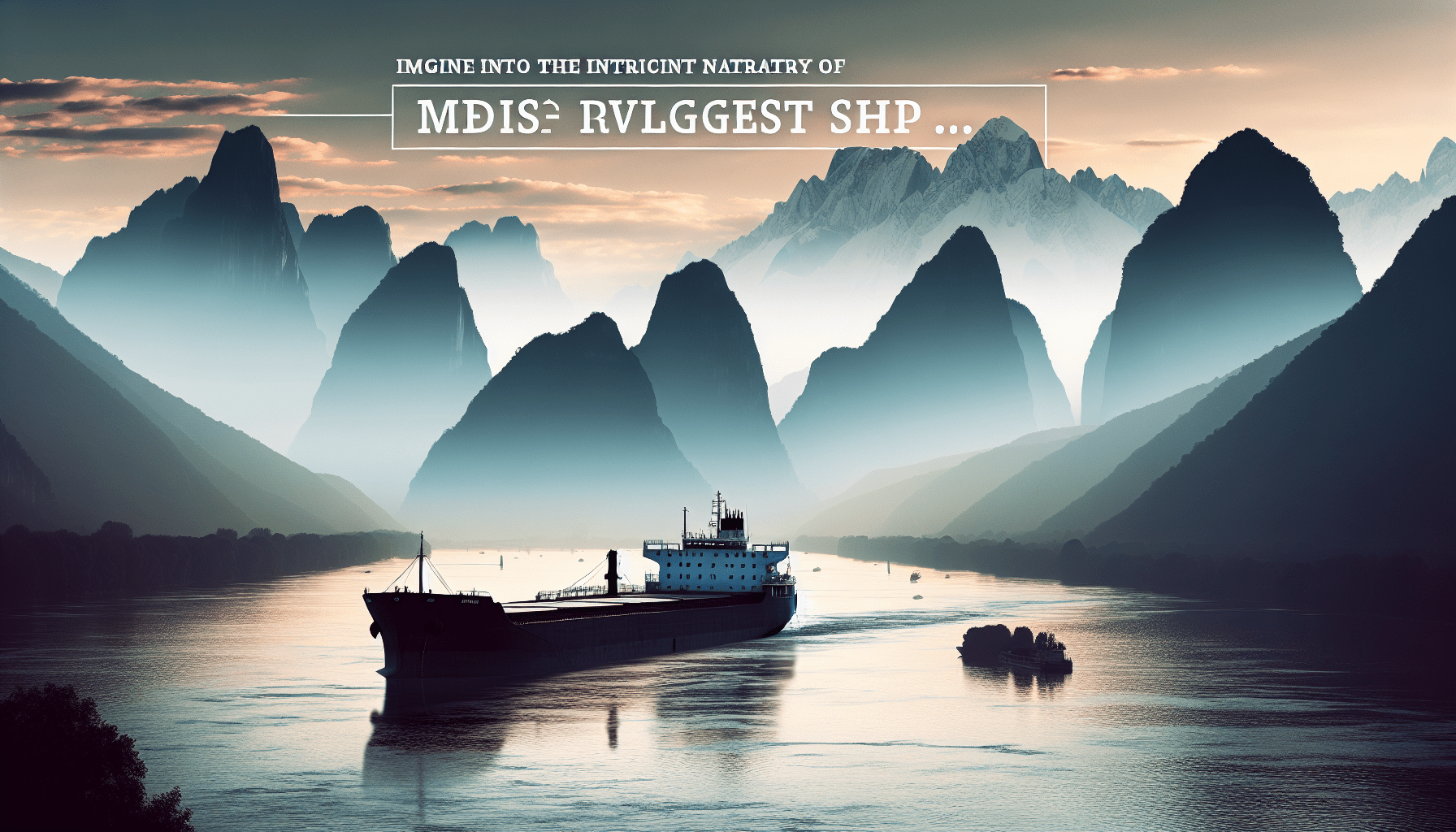
If you’ve ever wondered about the impressive vessels that navigate through the scenic waters of the Danube River, you’re not alone. The Danube, stretching across ten European countries, is home to a variety of ships, each with its own unique characteristics. Amongst these, one ship stands out as the largest, stealing the spotlight and capturing the imagination of river enthusiasts and curious onlookers alike. Embark on a virtual journey as we uncover the identity of the grandest ship that sails the majestic Danube.

Introduction to the Danube
The Danube is one of the major rivers in Europe, flowing through ten countries, making it the second longest river in the continent. It stretches for approximately 2,845 kilometers, beginning in the Black Forest of Germany and emptying into the Black Sea. The river plays a crucial role in connecting various countries, serving as a vital waterway for transportation and trade.
Location and importance of the Danube
The Danube runs through countries such as Germany, Austria, Slovakia, Hungary, Serbia, Romania, Bulgaria, Croatia, Ukraine, and Moldova. Due to its strategic location, the river has historically been a significant trade route, serving as a connection between the East and the West. Its navigable waters facilitate the movement of goods and people, linking major cities and regions along its course.
Historical significance of the Danube as a waterway
For centuries, the Danube has been an important waterway, playing a pivotal role in the development of trade and commerce in Europe. It provided a direct route for the transportation of goods, allowing for the exchange of various products, including grains, timber, minerals, and other valuable resources. The river has been instrumental in shaping the economic landscape of the regions it traverses, fostering cultural and economic ties between different nations.
Ship Specifications
When it comes to shipping on the Danube, understanding the specifications of the largest ships is essential. These ships need to navigate the winding river, often with changing water levels and narrow passages.
Length, width, and height of the largest ship
The largest ships that operate on the Danube typically have a length of around 135 meters, a width of approximately 11.45 meters, and a height of around 9.2 meters. These dimensions allow the ships to navigate the river while maximizing their capacity for cargo.
Deadweight and cargo capacity
The deadweight, which refers to the maximum weight a ship can carry, can vary based on the vessel. On the Danube, the largest ships generally have a deadweight capacity of around 10,000 to 15,000 metric tons. In terms of cargo capacity, these ships can transport various goods, including containers, bulk commodities, and liquid cargo.
Engine power and propulsion system
To ensure efficient navigation on the Danube, the largest ships are equipped with powerful engines and advanced propulsion systems. These ships commonly have engines with a power output ranging from 3,000 to 4,500 kilowatts, enabling them to overcome challenges such as strong currents and changing water levels.
Operational Features
The operational features of ships on the Danube play a crucial role in ensuring smooth navigation and efficient transport.
Navigational capabilities
Due to the nature of the Danube as a meandering river, ships need to have specialized navigational capabilities. Advanced navigation systems, radar technology, and GPS are commonly used to aid in safe and precise navigation. Additionally, ships on the Danube often have specific features to adapt to changing water levels, such as adjustable draft levels and adaptable propellers.
Crew size and accommodation facilities
The crew size required to operate the largest ships on the Danube typically ranges from 15 to 25 members. These well-trained professionals handle various tasks, including navigation, engine maintenance, and cargo operations. Accommodation facilities on board are designed to provide comfort and safety to the crew during their voyages along the river.
Safety features and certifications
Safety is a paramount concern in shipping, and ships on the Danube are equipped with various safety features to ensure the well-being of crew members, cargo, and the environment. These ships undergo rigorous inspections and certifications to comply with international safety standards. Features such as fire detection and suppression systems, life-saving equipment, and navigation aids are essential to mitigate potential risks and emergencies.
Transportation Role
The Danube plays a critical role in facilitating transportation and trade, providing a vital link between the countries it passes through.
Types of cargo transported on the Danube
Various types of cargo are transported along the Danube, catering to the diverse needs of industries and consumers. This includes containers, bulk commodities such as grains and minerals, liquid cargo such as oil and chemicals, as well as specialized cargo like heavy machinery and oversized equipment. The river serves as a lifeline for the transportation of these goods, connecting businesses and markets.
Significance for commerce and trade
The Danube has historically been a key trade route, linking countries in Central and Eastern Europe with Western Europe and beyond. It facilitates the movement of goods to and from landlocked countries, providing them access to international markets. The river’s navigability allows for cost-effective transportation, contributing to the growth of commerce and trade in the region.
Impact on the local economy
The transportation industry on the Danube has a significant impact on the local economies of the countries it passes through. It creates employment opportunities, both directly through the operation of ships and indirectly through related industries such as logistics and warehousing. Moreover, the efficient transport of goods enhances the competitiveness of businesses, driving economic growth and contributing to the overall development of the region.

Comparison to Other Rivers
Understanding how the Danube compares to other major rivers in terms of shipping is crucial to evaluate its advantages and disadvantages.
Largest ships on other major rivers
In comparison to other major rivers, the largest ships on the Danube are relatively smaller in size. For example, on the Mississippi River in the United States, ships can reach lengths exceeding 240 meters. Similarly, on the Rhine River in Western Europe, ships can have lengths surpassing 190 meters. The larger ship sizes on these rivers offer greater cargo capacity and potentially more efficient transportation.
Advantages and disadvantages of the Danube for shipping
While the Danube may have smaller ship sizes compared to other rivers, it has its own unique advantages and disadvantages. The narrower width and winding nature of the river can be challenging for navigation, but it also means that the Danube can reach more inland destinations. Additionally, the Danube’s strategic location allows for valuable connections to various countries and regions, contributing to the overall efficiency of transportation and trade.
Environmental Considerations
In an era of growing concern for the environment, it is important to examine the environmental aspects of shipping on the Danube.
Fuel consumption and emissions
Like any other mode of transportation, ships on the Danube consume fuel and emit emissions. The fuel consumption and emissions depend on various factors, including ship size, engine efficiency, and the type of fuel used. Efforts are being made to optimize fuel consumption and reduce emissions through the use of cleaner fuels, such as low-sulfur diesel, as well as the implementation of energy-saving measures and technologies.
Measures taken to minimize environmental impact
To minimize the environmental impact, comprehensive measures are being implemented within the shipping industry on the Danube. These measures include proper waste management, pollution control measures, and adherence to international regulations. Additionally, awareness and educational programs are being conducted to promote environmental responsibility among crew members and stakeholders.
Ecological challenges on the Danube
The Danube is home to a diverse range of ecosystems, supporting numerous plant and animal species. However, environmental challenges such as pollution, habitat destruction, and invasive species pose threats to the river’s ecological balance. Efforts are being made to address these challenges through conservation initiatives, restoration projects, and the establishment of protected areas.
Future Developments
The future of shipping on the Danube holds potential for further advancements and collaborations among the countries along its course.
Potential for larger ships on the Danube
As technology progresses, there is the potential for larger ships to operate on the Danube. This would allow for increased cargo capacity and potentially more efficient transportation. However, any such developments would need to consider the navigational challenges posed by the river’s natural characteristics.
Improvements in infrastructure and navigation
Investments in infrastructure and navigation are crucial to ensure the continued growth and efficiency of shipping on the Danube. This includes the modernization of ports, the enhancement of navigational aids, and the development of efficient logistics networks. Collaborative efforts between countries along the river would be essential to drive these improvements.
Collaboration between Danube countries for shipping
Collaboration between the countries that the Danube flows through is vital for the sustainable development of shipping on the river. Cooperative initiatives in areas such as infrastructure development, navigational safety, and environmental protection can strengthen the transportation network and promote mutual benefits. By working together, these countries can harness the full potential of the Danube as a vital waterway.
Conclusion
In conclusion, the Danube serves as a crucial waterway for transportation and trade, connecting countries and regions in Europe. The largest ships on the Danube have specific specifications to navigate the river’s unique characteristics, allowing for the efficient transport of various types of cargo. The Danube’s historical significance, economic impact, and environmental considerations make it an essential component of the transportation industry. As the future unfolds, collaborations and developments hold the potential to further optimize shipping on this remarkable river.



